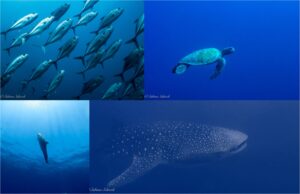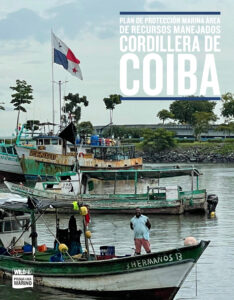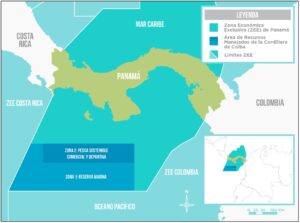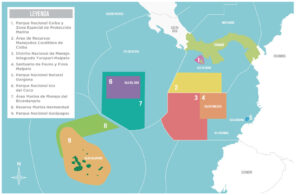WildAid and MigraMar Partner with Panama to Stop Illegal Fishing in the New Coiba Ridge Marine Protected Area
May 19, 2023; By Carolyn Sotka, Marine Grants Officer
In April 2023, WildAid Marine delivered a Marine Protection System (MPS) Plan to Panama’s Ministry of the Environment (MiAmbiente) to address illegal, unreported and unregulated (IUU) fishing in the Cordillera de Coiba Managed Resource Area (ARMCC). The ARMCC is an offshore marine protected area (MPA) that was expanded in 2021 to conserve an underwater mountain range with exceptional geological formations, seamounts, deep sea trenches and rich biodiversity.
ARMCC is home to marine mammals and sea turtles that use the area as a migration swimway and feeding area, and over 300 species of fish such as mantas, tunas and sharks, with several listed as vulnerable or endangered according to the IUCN. With this expansion along the Coiba Ridge, Panama became the second country in the Eastern Tropical Pacific to protect at least 30% of its waters – a global target scientists say is needed to secure the long-term health of the ocean.
Thanks to the support of the Blue Nature Alliance and MigraMar, WildAid Marine partnered with Skylight and Panama’s Ministry of the Environment (MiAmbiente) to provide recommendations as part of an MPS Plan for a marine control, enforcement and surveillance strategy for the ARMCC.

The ARMCC serves as a key link within the Eastern Tropical Pacific for highly migratory species, and the Coiba Ridge is a refuge for threatened wildlife and unique habitat for thousands of species. Photo credit: Sabina Schreck, Panama Dive Center
MigraMar is the leading scientific authority in migratory species research in the Eastern Tropical Pacific Ocean. MigraMar played a critical role in the expansion of the ARMCC by informing the Panamanian government and other stakeholders about the function, connectivity and importance of MPAs to protect threatened migratory species across the region.

The MPS Plan identified a need to augment knowledge and capabilities of Panamanian agencies to leverage remote monitoring tools, enhance interagency coordination, and utilize a full suite of investigative methods to address illegal fishing and prohibited acts within the ARMCC.
The ARMCC expands protection south towards the border of Panama’s maritime border with Colombia and geopolitically connects the Exclusive Economic Zones (EEZs) of Panama, Costa Rica, Colombia, and Ecuador. The expanded ARMCC is part of a transnational mega-MPA known as the Eastern Tropical Pacific Marine Corridor (Corredor Marino del Pacífico Este – CMAR). Without effective enforcement across the area, in addition to the MPAs within it, the overall benefits to the region as an important migratory corridor will be challenging to achieve.

Map illustrates the ARMCC including two zones, one being a fully protected no-take marine reserve (Zona 1) and for commercial and recreational fishing (Zona 2). Also lines indicate border with the EEZs (ZEE) of Costa Rica and Columbia.
WildAid’s MPS Plan for Panama includes a multi-year roadmap in alignment with the ARMCC’s Management Plan and a cross-agency strategy to improve coordination to address threats to wildlife and habitat. This includes use of new technologies to identify suspicious vessel behavior and alert authorities who can investigate, and take enforcement and compliance action when necessary. Further, the MPS Plan is designed to identify capacity and capability conditions related to the chain of enforcement and better enable detection and prosecution of illegal activities.
Key findings included the need to strengthen cooperation and collaboration on fisheries enforcement among agencies in Panama, as well as internationally with Colombia and Costa Rica. Specifically, the use of a centralized monitoring center could help coordinate responses to illegal activities and provide a framework to accomplish Panama’s ambitious goals for marine conservation and management.
Other MPS plan recommendations include mechanisms to increase detection of fisheries crimes by examining the flow of commerce and links between businesses (e.g. investigating the presence of criminal networks); conducting investigation of fisheries crimes via cooperative agreements; developing a trained investigative unit for fisheries crimes, and standardizing patrol logs and shared databases for all agencies. Also, recommended is a fleet inventory for fisheries enforcement agencies to maximize use of shared resources. Ultimately, increasing access to information and the investigative capacity of personnel assigned to the ARMCC through coordinated planning and joint patrolling is essential for effective enforcement.
The first phase of the MPS Plan implementation was a comprehensive training for MiAmbiente staff on the use of satellite monitoring tools to detect and track illegal fishing and vessels in the ARMCC.
In addition to Panama, WildAid Marine has assessed and delivered MPS Plans for other hotspots across the transnational mega-MPA CMAR. WildAid has provided effective enforcement solutions in partnership with the Galapagos National Park in Ecuador for nearly two decades and the newly designated ‘Reserva Marina de Hermandad’ that creates a massive ‘swimway’ between Ecuadorian and Costa Rican waters. In 2022, WildAid delivered an MPS Plan for Cocos Islands in Costa Rica, and hopes to expand programs to additional MPAs in partnership with Columbia.
 The Corredor Marino del Pacífico Este (CMAR) includes Panama’s Coiba Island National Park (1) and ARMCC (2); Columbia’s Yurupari-Malpelo Managed Areas and Sanctuary (3&4) and Gorgona National Park (5); Costa Rica’s Coco Island National Park (6) and Bicentennial MPA (7); and Ecuador’s Hermandad Marine Reserve (8), and Ecuador’s Galapagos Island National Park (9).
The Corredor Marino del Pacífico Este (CMAR) includes Panama’s Coiba Island National Park (1) and ARMCC (2); Columbia’s Yurupari-Malpelo Managed Areas and Sanctuary (3&4) and Gorgona National Park (5); Costa Rica’s Coco Island National Park (6) and Bicentennial MPA (7); and Ecuador’s Hermandad Marine Reserve (8), and Ecuador’s Galapagos Island National Park (9).
 Fishing port near Casco Viejo, Panama City’s historic district.
Fishing port near Casco Viejo, Panama City’s historic district.